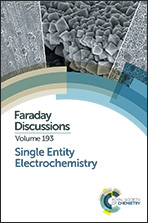Voltammetry and molecular assembly of G-quadruplex DNAzyme on single-crystal Au(111)-electrode surfaces – hemin as an electrochemical intercalator
Abstract
DNA quadruplexes (qs) are a class of “non-canonical” oligonucleotides (OGNs) composed of stacked guanine (G) quartets stabilized by specific cations. Metal porphyrins selectively bind to G-qs complexes to form what is known as DNAzyme, which can exhibit peroxidase and other catalytic activity similar to heme group metalloenzymes. In the present study we investigate the electrochemical properties and the structure of DNAzyme monolayers on single-crystal Au(111)-electrode surfaces using cyclic voltammetry and scanning tunnelling microscopy under electrochemical potential control (in situ STM). The target DNAzyme is formed from a single-strand OGN with 12 guanines and iron(III) porphyrin IX (hemin), and assembles on Au(111) through a mercapto alkyl linker. The DNAzyme monolayers exhibit a strong pair of redox peaks at 0.0 V (NHE) at pH 7 in acetate buffer, shifted positively by about 50 mV compared to free hemin weakly physisorbed on the Au(111)-electrode surface. The voltammetric hemin signal of DNAzyme is enhanced 15 times compared with that of hemin adsorbed directly on the Au(111)-electrode surface. This is indicative of both the formation of a close to dense DNAzyme monolayer and that hemin is strongly bound to the immobilized 12G-qs in well-defined orientation favorable for interfacial ET with a rate constant of 6.0 ± 0.4 s−1. This is supported by in situ STM which discloses single-molecule G-quartet structures with a size of 1.6 ± 0.2 nm.
- This article is part of the themed collection: Single Entity Electrochemistry


 Please wait while we load your content...
Please wait while we load your content...